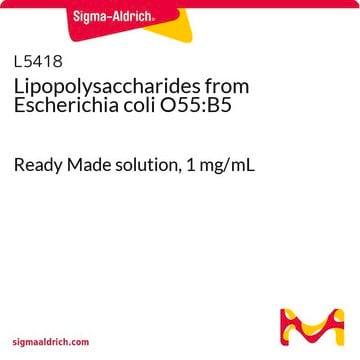MAK339
Lipopolysaccharide (LPS) Isolation Kit
sufficient for 10 isolation(s)
Synonym(e):
LPS Extraction Kit
Anmeldenzur Ansicht organisationsspezifischer und vertraglich vereinbarter Preise
Alle Fotos(3)
About This Item
UNSPSC-Code:
12161503
Empfohlene Produkte
Verwendung
sufficient for 10 isolation(s)
Anwendung(en)
sample preservation
Lagertemp.
−20°C
Allgemeine Beschreibung
The outer membrane of gram-negative bacteria contains lipopolysaccharide (LPS), a low molecular weight carbohydrate with a molecular mass of 10-20 kDa. It is heterogeneous and composed of O antigen (a repeating glycan polymer), core oligosaccharide (which links the O antigen to Lipid A - the third component, and non-carbohydrate components such as phosphate and amino acids groups. Lipid A, has multiple fatty acids which serve to anchor LPS into the bacterial membrane allowing the O antigen and core oligosaccharide to protrude and contributes to a major part of the toxicity of gram-negative bacteria. Also known as endotoxin, when consumed by animals, LPS induces a strong inflammatory response and/or sepsis.
Eignung
Suitable for the isolation of Lipopolysaccharides from outer membrane of gram negative bacteria.
Prinzip
The Lipopolysaccharide (LPS) Isolation Kit uses bacterial membrane lysis buffer and protein digestion to yield micrograms of LPS from bacterial culture (approximately 1-4% of dry weight). This kit does not use chloroform or phenol like traditional methods, and it will yield pure LPS in less than 2 hours that can be easily characterized and quantified.
Signalwort
Danger
H-Sätze
Gefahreneinstufungen
Met. Corr. 1 - Resp. Sens. 1
Lagerklassenschlüssel
8A - Combustible corrosive hazardous materials
Flammpunkt (°F)
Not applicable
Flammpunkt (°C)
Not applicable
Analysenzertifikate (COA)
Suchen Sie nach Analysenzertifikate (COA), indem Sie die Lot-/Chargennummer des Produkts eingeben. Lot- und Chargennummern sind auf dem Produktetikett hinter den Wörtern ‘Lot’ oder ‘Batch’ (Lot oder Charge) zu finden.
Besitzen Sie dieses Produkt bereits?
In der Dokumentenbibliothek finden Sie die Dokumentation zu den Produkten, die Sie kürzlich erworben haben.
Zhiyuan He et al.
Microbiome, 10(1), 79-79 (2022-06-02)
Antimicrobials are often used to prevent and treat diarrhea induced by enteroaggregative Escherichia coli (EAEC) in young ruminants. However, drug overuse or misuse accelerates the spread of multidrug-resistant extended-spectrum β-lactamase (ESBL)-producing E. coli. Thus, supplementary foods as alternatives to antibiotics
Zhiyuan He et al.
Frontiers in nutrition, 9, 864080-864080 (2022-04-12)
Calf diarrhea induced by enteroaggregative E. coli (EAEC) spreads fast among young ruminants, causing continuous hazard to dairy industry. Antimicrobial drug abuse aggravates the incidence rate of multi-drug resistant (MDR) extended-spectrum β-lactamase-producing E. coli (ESBL-EC). However, knowledge of detection and
Unser Team von Wissenschaftlern verfügt über Erfahrung in allen Forschungsbereichen einschließlich Life Science, Materialwissenschaften, chemischer Synthese, Chromatographie, Analytik und vielen mehr..
Setzen Sie sich mit dem technischen Dienst in Verbindung.






